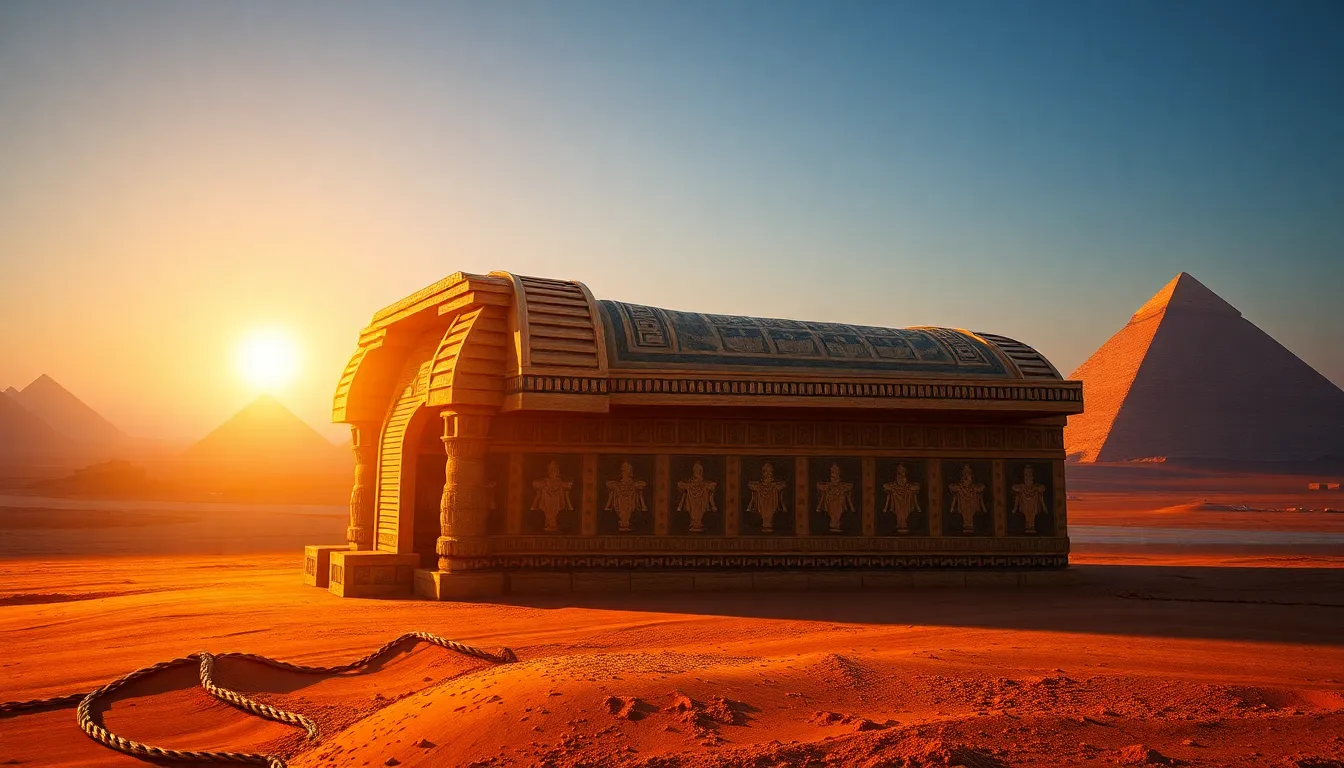The Sacred Geometry of the Pharaoh’s Sarcophagus
I. Introduction
Sacred geometry is a term used to describe the symbolic and sacred meanings attributed to certain geometric shapes and proportions. This concept has played a crucial role in various cultures throughout history, and in ancient Egypt, it was particularly significant. The Pharaoh’s sarcophagus serves not only as a resting place for the deceased but also as a powerful symbol of the divine connection between the earthly and the spiritual realms. This article will explore the intricate relationship between geometry and symbolism in the context of the Pharaoh’s sarcophagus, shedding light on how these elements intertwined to reflect the ancient Egyptians’ beliefs about the afterlife and immortality.
II. Historical Context of the Pharaoh’s Sarcophagus
The sarcophagus, a stone coffin, was an essential component of ancient Egyptian burial practices. It was designed to protect the mummified body of the Pharaoh and to ensure a safe passage to the afterlife. Throughout the dynasties, the sarcophagus evolved in design and complexity, reflecting the increasing sophistication of Egyptian craftsmanship and beliefs.
- The role of sarcophagi: Sarcophagi were often intricately decorated with hieroglyphs and images that depicted the deceased’s journey through the afterlife.
- Notable Pharaohs: Famous Pharaohs such as Tutankhamun and Ramses II had elaborate sarcophagi that showcased their power and divine status.
- Evolution of design: From simple wooden boxes to elaborate stone structures, the design of sarcophagi changed significantly across different dynasties, reflecting advancements in artistry and architectural techniques.
III. Understanding Sacred Geometry
Sacred geometry encompasses various geometric principles that are believed to represent fundamental aspects of the universe. These concepts include shapes such as circles, triangles, and squares, which carry deep spiritual significance.
- Geometric concepts: The study of shapes, patterns, and their relationships is central to sacred geometry.
- Significance in ancient cultures: Many ancient civilizations, including the Egyptians, used geometric patterns in their art and architecture to reflect their understanding of the cosmos.
- Spiritual connections: Sacred geometry often symbolizes the connection between the material and spiritual worlds, representing the harmony and order of the universe.
IV. Geometric Patterns Found in Pharaoh’s Sarcophagi
Pharaoh’s sarcophagi are adorned with various geometric patterns that convey deep symbolic meanings. Common shapes and symbols found in these ancient artifacts include:
- Circles: Often represent eternity and the cyclical nature of life and death.
- Squares: Symbolize stability and the material world.
- The golden ratio: This mathematical ratio, often found in nature, was used in the construction of sarcophagi to create aesthetically pleasing proportions.
Specific sarcophagi, such as that of Tutankhamun, showcase these geometric features remarkably. The intricate designs not only enhance the visual appeal but also serve to communicate the Pharaoh’s divine status and the significance of the afterlife.
The use of geometry in these contexts symbolizes the Egyptians’ beliefs in immortality and the intricate relationship between life, death, and rebirth.
V. The Symbolism of Shapes and Dimensions
The shapes and dimensions found in Pharaoh’s sarcophagi are rich with symbolism. Different geometric forms are interpreted in various ways, often reflecting the mythology and spiritual beliefs of ancient Egypt.
- Interpretation of shapes: For instance, the lotus flower, often depicted in Egyptian art, symbolizes creation and regeneration.
- Symbolic meanings: Specific measurements, such as the ratios used in construction, can reflect cosmic order and divine proportion.
- Cosmic dimensions: The dimensions of sarcophagi often mirror celestial bodies and align with significant astronomical events, further emphasizing the connection between the earthly and divine realms.
VI. The Construction Techniques and Materials
The craftsmanship behind the creation of sarcophagi reflects the advanced engineering and artistry of ancient Egyptian builders. Various materials were utilized in the construction, including:
- Granite: Known for its durability and strength, granite was often used for royal sarcophagi.
- Limestone: This softer stone allowed for intricate carvings and detailed inscriptions.
- Wood: In earlier periods, wooden sarcophagi were common, often decorated with paint and gold leaf.
The relationship between geometry and structural integrity is evident in the design of these sarcophagi. The use of precise measurements and angles not only created aesthetically pleasing forms but also ensured the durability and stability of the structures.
VII. Modern Interpretations and Discoveries
Recent archaeological discoveries have shed new light on the sacred geometry of the Pharaoh’s sarcophagus. Advances in technology, such as 3D scanning and digital analysis, have allowed researchers to explore these ancient artifacts in unprecedented detail.
- Archaeological findings: New sarcophagi and burial sites continue to be uncovered, revealing complex geometric designs and symbolism.
- Impact of technology: Modern tools enable a deeper understanding of the construction techniques and artistic choices made by ancient builders.
- Contemporary relevance: The principles of sacred geometry continue to inspire artists and architects today, reflecting a timeless connection between beauty, spirituality, and mathematics.
VIII. Conclusion
In summary, the Pharaoh’s sarcophagus is a profound testament to the intersection of art, spirituality, and mathematics in ancient Egyptian culture. Through the lens of sacred geometry, we can appreciate the intricate designs and symbolic meanings embedded in these monumental creations. The lasting legacy of the Pharaoh’s sarcophagus not only enriches our understanding of ancient Egyptian beliefs but also invites us to explore the deeper connections between shape, dimension, and the cosmos.
As we continue to uncover the mysteries of the past, the study of sacred geometry remains a vital aspect of understanding the rich tapestry of human history and the universal quest for meaning and connection to the divine.




